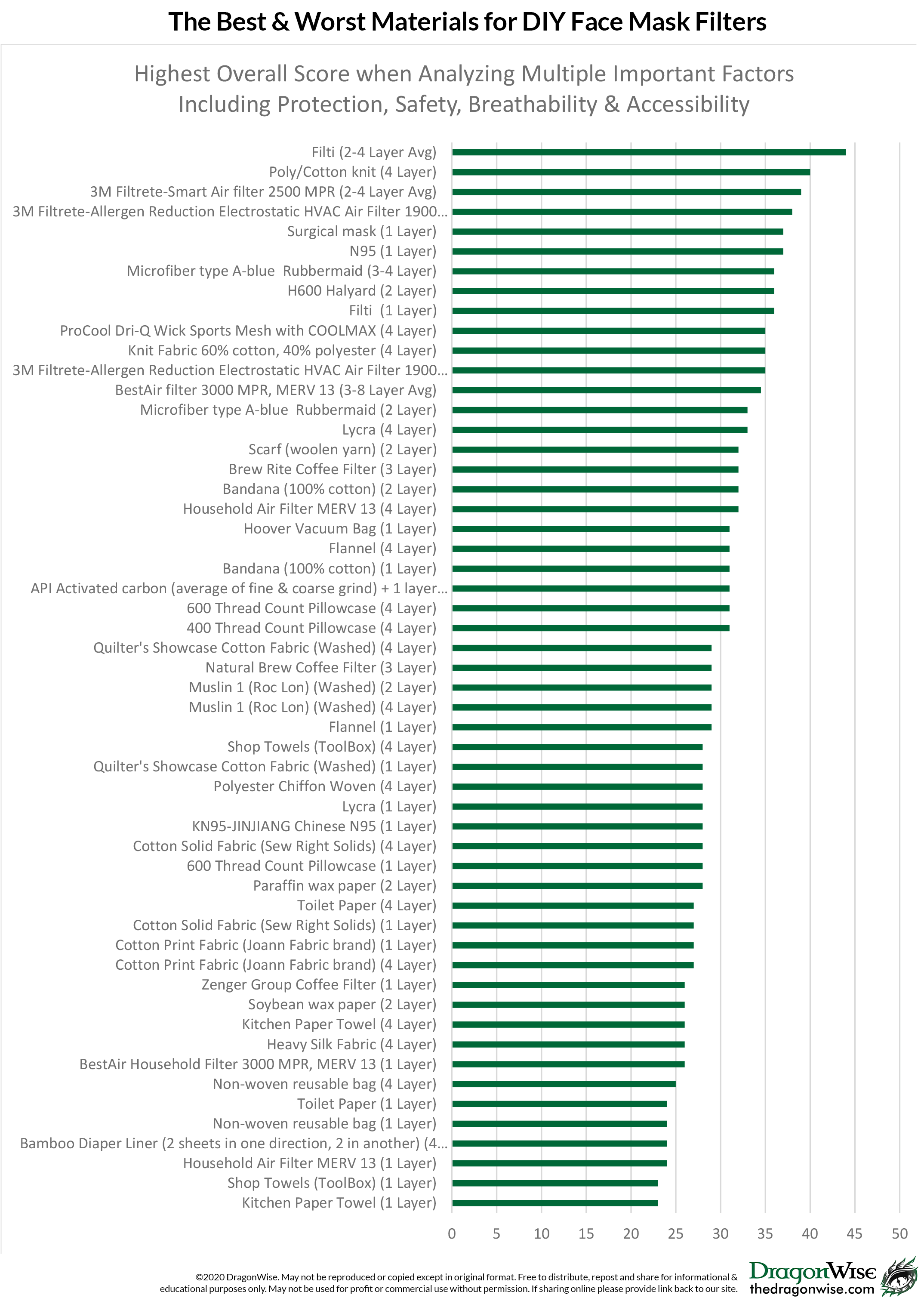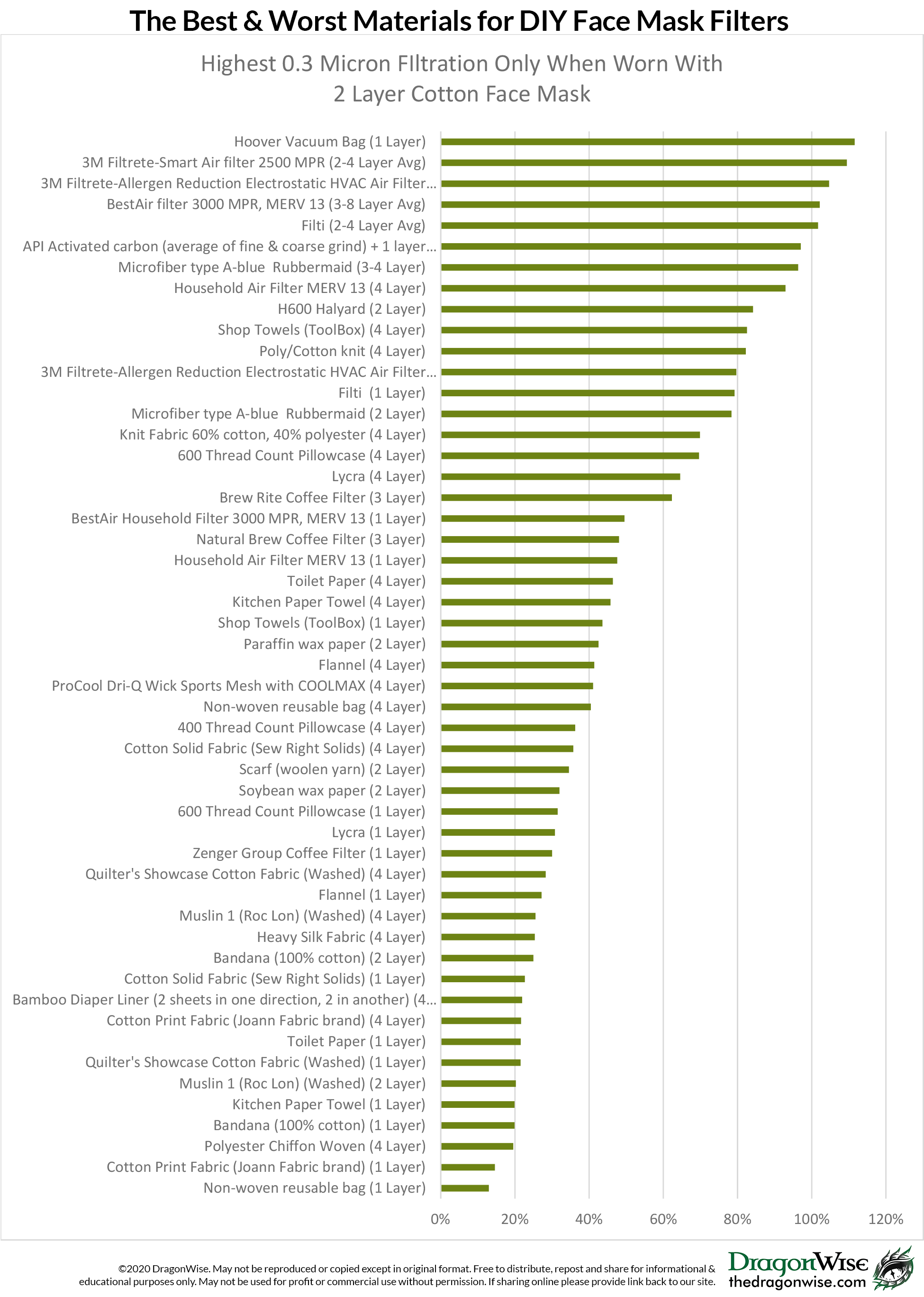The Best & Worst Materials for DIY Face Mask Filters
In our exploration of the answer to the question “Is a filter needed for face masks?”, we discussed how the right face mask filter can potentially boost well-fitting fabric masks to the same level of protection or even higher than an N95 mask. By now multiple studies have been done to determine what alternative materials can be used for protective face coverings so that the limited supply of N95 and medical face masks can be reserved for medical professionals and first responders.
While these studies have looked at performance on filtration and breathability, there is no comprehensive analysis published that combines key conclusions from these studies with other practical factors such as trustworthiness of the material quality or manufacturer, the potential for harmful chemicals or fiberglass, the price, and the accessibility to the consumer.
A recent study, “Filtration Performances of Non-Medical Materials as Candidates for Manufacturing Facemasks and Respirators”, published in the International Journal of Hygiene and Environmental Health, tested a wide variety of materials and scenarios to get data on the filtration ability and breathability. Two of the authors, Dr. Yang Wang, assistant professor of environmental engineering at Missouri S&T, and his Ph.D. student, Weixing Hao evaluated filtration based on blocking of 0.3 micron particles, the size generally used as a benchmark for COVID-19 protection.
Wang & Hao found that some of the most protective materials also offering the best breathability were household (furnace & HVAC) air filters, which are specifically designed for filtering environmental air. Many people have been using these, but the problem is some of these filters can have fiberglass or other dangerous components in them that can be breathed in and cause as much harm to the wearer as the contaminants they are trying to avoid.
One argument suggests that these types of filters are safe to use as long as they are sandwiched between a high thread count cotton fabric. However, this is not proven and small particles may potentially pass through the fabric into the lungs. Due to the potential risk, we do not recommend relying on these materials even when wrapped in cloth. It is best to pick filters without dangerous components, and ones using longer woven fibers may shed less than ones with smaller fibers.
Since early in the COVID-19 outbreak, shop towels have been touted as an effective alternative material for homemade masks and filters. Surprisingly, in this study they only filtered 32% of particles unless stacked in 4 layers which only improved filtration to 70% and suffered a noticeable loss in breathability.
Other fabric tested included cotton and muslin. Both were consistently mediocre, yielding around 10% protection unless stacked in 3-4 layers, which improved filtration to 15-25%. Even 4 layers of 600 thread count cotton only blocked 58% of particles.
Another study published in The Journal of Hospital Infection, “COVID-19 and Non-Traditional Mask Use: How Do Various Materials Compare in Reducing the Infection Risk for Mask Wearers?” led by author Amanda Wilson, a doctoral candidate in environmental health sciences, aimed to predict the risk of infection when exposed to the virus for different durations using varied materials. In her study using a probabilistic model based on known data from several studies, vacuum cleaner bags came out on top just under surgical masks, and things like cotton or linen or a scarf scored the lowest. These results compliment the results found by Wang & Hao and showed an expected correlation between material efficiency and a reduction in risk of infection when exposed over time to airborne particles.
A good DIY material for a filter should do the following:
- Filter as many 0.3 micron particles as possible, MERV 16 or higher is ideal because that will natively filter 95% of 0.3 micron particles
- Be breathable enough to allow proper airflow through the filter material
- Be large enough to cover the nose and mouth
- Contain no dangerous chemicals or particles that may be breathed in during use
After reviewing the data from these studies, we conducted our own analysis evaluating the best and worst materials for DIY face mask filters. First we combined relevant data and added additional parameters important to overall performance and feasibility. Next we researched the additional information required. Finally, we assigned quantitative values to each parameter weighted by importance. For example – protection and safety of the materials carried more weight than price point.
Using this method, we calculated an overall numerical value for each material to allow for easy and clear sorting based on this final score.
Our first table shows the score summary of a sampling of materials ranked from best to worst based on the all the factors we analyzed.
Top 3 face mask filter materials, multiple layers (best listed first)
- Filti Material, 2-4 layers
- Poly/Cotton Knit Fabric, 4 layers
- 3M Filtrete-Smart Air filter 2500 MPR, 2-4 Layers
Top 3 face mask filter materials, single layers (best listed first)
- N95 Mask & Surgical Masks, 1 layer
- Filti Material, 1 layer
- 3M Filtrete-Allergen Reduction Electrostatic HVAC Air Filter 1900 MPR, MERV 12, 1 Layer
Bottom 3 face mask filter materials, multiple layers (worst listed first)
- Bamboo Diaper Liner (4 Layer)
- Non-woven reusable bag (4 Layer)
- Soybean wax paper (2 Layer)
Bottom 3 face mask filter materials, single layers (worst listed first)
- Shop Towels (ToolBox), 1 layer
- Kitchen Paper Towel, 1 layer
- Toilet Paper, 1 layer

This table shows the full scores we assigned to the materials. Click image to enlarge in a new window
Below left see the materials ranked from best to worst in a graph based on overall score. Compare against below right, which ranks materials based on particle filtration level alone. Note the differences, and understand why it is important to consider all factors when choosing a material to make DIY filters.


Reported numbers may vary in practical applications. Please use this chart as a guide for comparing materials relative to each other and not as a reference for exact percentages of filtration or reduced risk of infection. Values may change slightly based on testing equipment, inconsistencies in the materials, or the practical use of the materials in a face mask since filtration efficiency relies on variables such as face mask fit and coverage.
We hope our analysis will assist DIYers in making their own face mask filters to boost the performance of their fabric face masks! If you have any designs or thoughts you’d like to share we’d love to hear from you in the comments.
We are happy to answer any inquiries for more information about why we rated things the way we did in our analysis. Periodically data may be updated; if you have any valid scientific or other information that conflicts with this article please send it to us for review at: service@thedragonwise.com.
References
Hao, Weixing, et al. “Filtration Performances of Non-Medical Materials as Candidates for Manufacturing Facemasks and Respirators.” International Journal of Hygiene and Environmental Health, vol. 229, 1 Aug. 2020, p. 113582, https://www.sciencedirect.com/science/article/pii/S1438463920305289?via%3Dihub, 10.1016/j.ijheh.2020.113582.
Wilson, Amanda M., et al. “COVID-19 and Non-Traditional Mask Use: How Do Various Materials Compare in Reducing the Infection Risk for Mask Wearers?” The Journal of Hospital Infection, 2 June 2020, https://www.ncbi.nlm.nih.gov/pmc/articles/PMC7264937/, 10.1016/j.jhin.2020.05.036.
Konda, Abhiteja, et al. “Aerosol Filtration Efficiency of Common Fabrics Used in Respiratory Cloth Masks.” ACS Nano, 24 Apr. 2020, https://pubs.acs.org/doi/10.1021/acsnano.0c03252.









